
Maruti Dzire vs Honda Amaze Diesel Manual: Road Test Review
- Oct 25, 2018
- Views : 18967

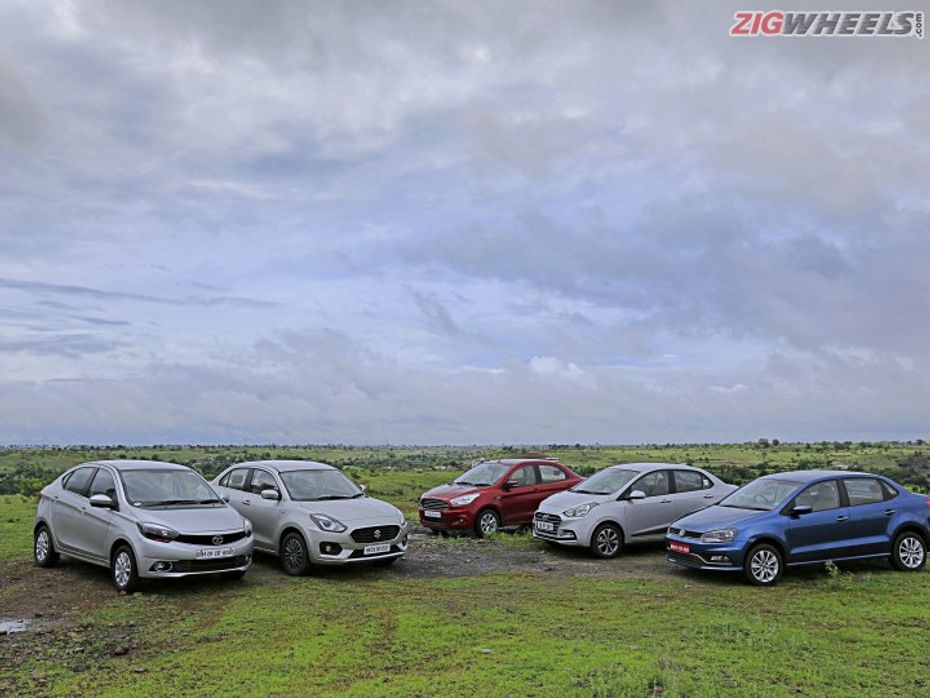
By now we’re all familiar with the formula for the class but just in case, let me reiterate - for manufacturers to receive ‘small car’ duty benefits, cars can’t be longer than four meters and must feature a diesel engine smaller than 1,500cc or a petrol engine smaller than 1,200cc. And in pandering to the demand for an affordable ‘big car’ (which usually has a boot instead of a hatch), all of our protagonists follow a three-box, sedan design. Trying to keep the Maruti Suzuki Dzire honest on this test are the Volkswagen Ameo, the Ford Aspire, Tata Tigor and the Hyundai Xcent.
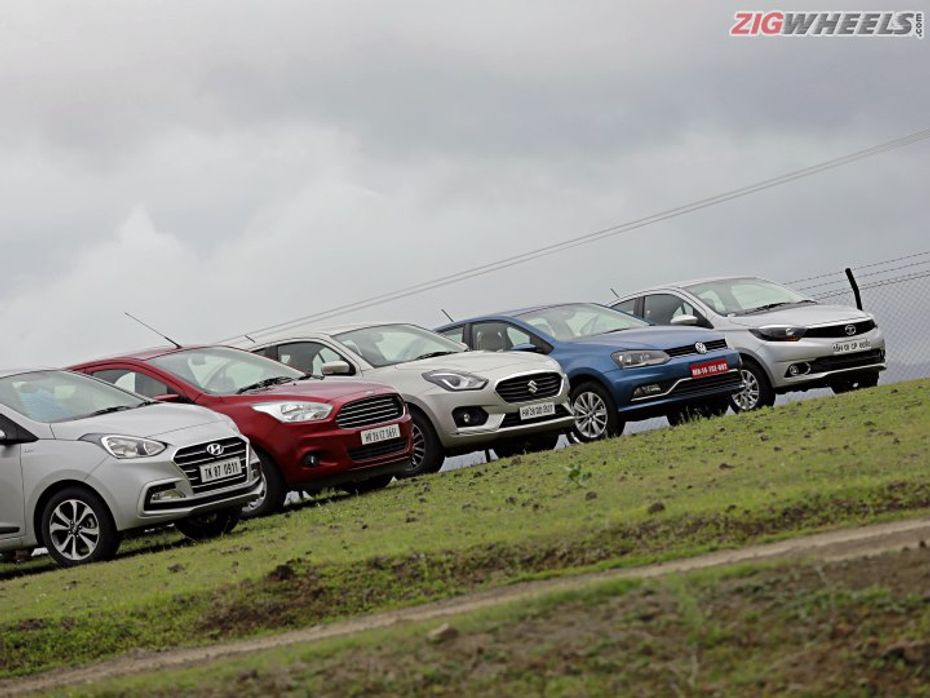
The Maruti Suzuki Dzire has AMT options in both petrol and diesel engines while Hyundai only offers a conventional automatic with their petrol-engined car. The Aspire offers a dual clutch automatic petrol and the Ameo is the only car to offer a dual clutch diesel option. But we’ve chosen the top-end diesel cars with manual transmissions which we feel will serve the need for most of you out there.
From drab to dapper
When the compact sedan class came into existence in 2008, the simple formula was to add a boot to a hatchback to make it into a sedan and the quick-and-dirty solution meant that none of the initial designs won any beauty contests. The segment has evolved quite a bit since 2008, but the Volkswagen Ameo has stuck to the simple formula. It could just as easily be mistaken for the Polo from most angles. While the Polo is not an unattractive car, the Ameo when viewed from the side feels the least attractive of the lot with the short stubby boot sticking out like a sore thumb. Volkswagen has made quite a few changes like shortening the nose to offset the larger boot, keeping it under the four-meter mark, but they’ve been more engineering than aesthetic changes and haven’t done enough to disguise what is essentially a boot job.
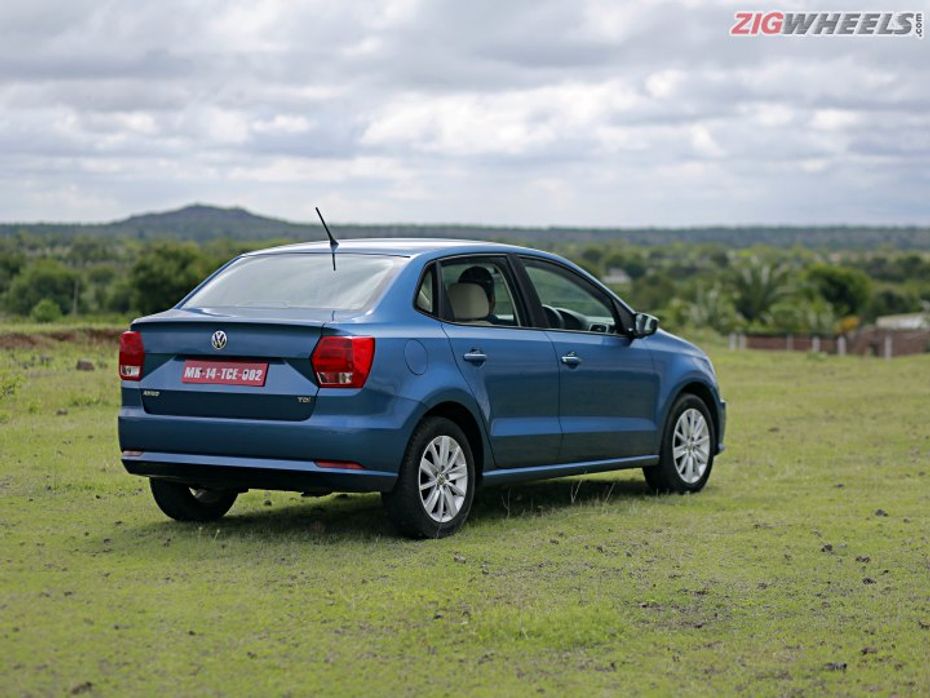
The Hyundai Xcent just received a facelift this year and it has added new DRLs housed in a new bumper that has given the Hyundai a nice smiling face. Hyundai’s Fludic 2.0 design language seems to have taken on a bit of a gawky look with this facelift. There are a lot of edges and curves and the addition of the boot has been disguised quite nicely. But overall, the balance just seems a little off as the Xcent ends up looking a bit narrow and timid, especially when viewed from the rear.

The Ford Aspire is next up with a very attractive and sporty face that is dominated by a large front grill. It also really looks like it was designed to be a sedan with the boot nicely integrated into the design. The fly in its ointment is the somewhat “flat panelled” look of the sides. It may be a design that is more economical and utilises space better, but it isn’t quite pleasing to look at and though it’s a just a two year-old design it’s already starting to show its age.
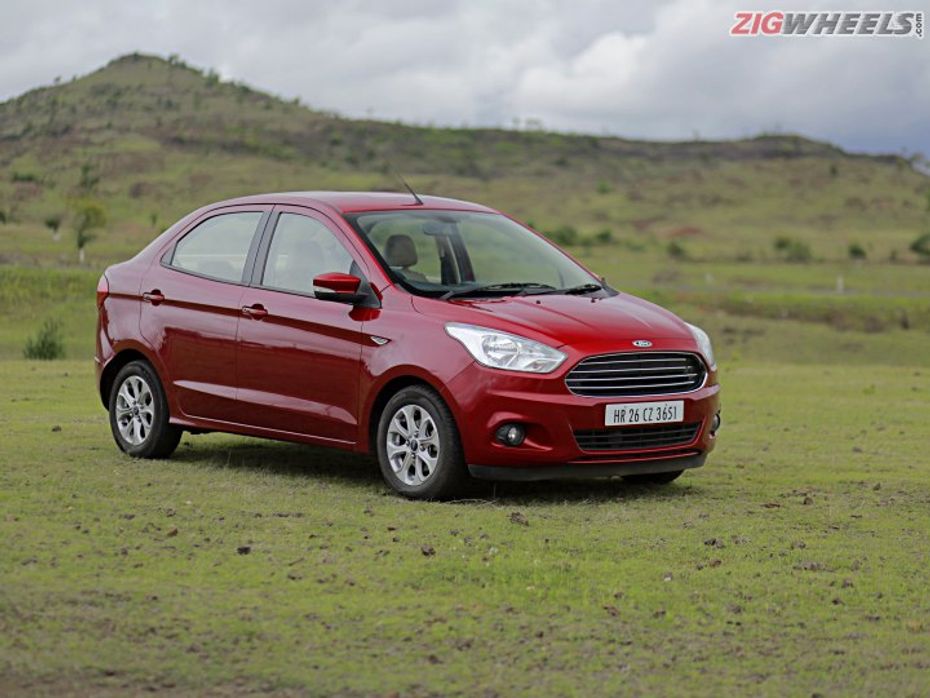
The Tata Tigor is a pleasant surprise from Tata with a much sharper design from the soft, rounded shapes we’ve become accustomed to from their stables. Although its face is related to the Tiago, Tata redrew the lines right from the B-Pillar onwards so that the design flows seamlessly, fore to aft. The large curved front grill and sharp bonnet line give it an attractive shark like nose. At the rear, the design is also nice with a large chrome accent connecting the two taillights. Then there is the two foot long brake light strip just under the mini roof wing that just shouts out for attention whenever you hit the brakes. Overall, it could be one of the nicest designs from Tata yet.

That brings us to the Dzire, the newest of the quintet and an all-new car. While it may borrow the face of the new Swift that’s expected early next year, from the A-pillar rearwards, it’s a completely different car. The sporty hexagonal grille at the front flows through to nice flared wheel arches that are also the reason for an increase in overall width by 40mm. It’s quite easily the best looking of the lot.
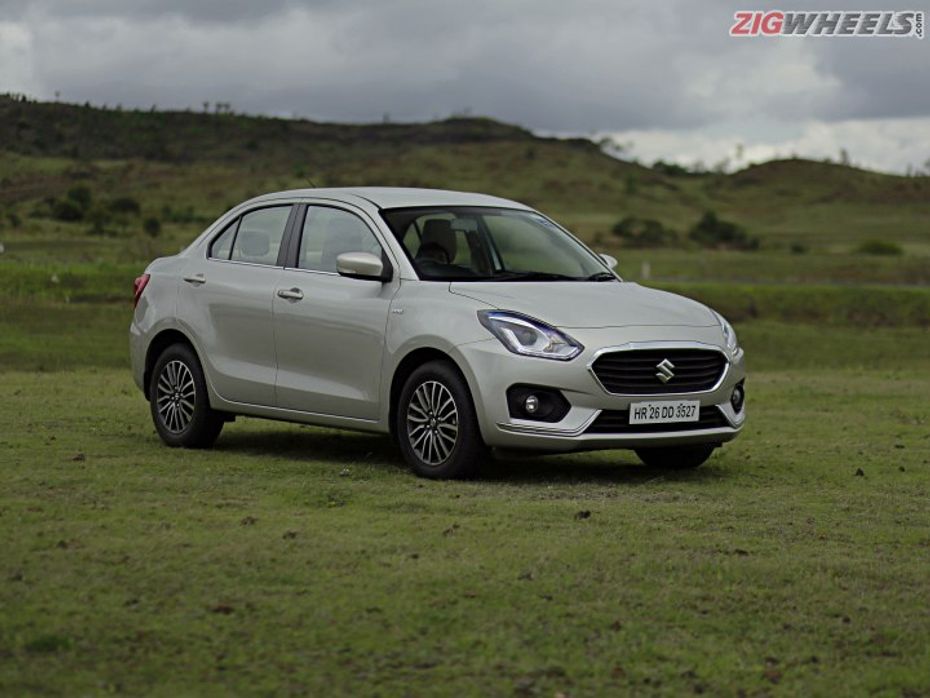
It’s all about the space
This segment was born out of the desire for something more. The ultimate paradox for manufacturers - the space and comfort of a sedan packed into a tiny package- has been achieved with varying degrees of success. In addition to looking at the overall quality of interiors and the comfort for four adult passengers, we also decided to test each car’s ability to fit three adults in the rear bench since that’s what most owners do anyway.
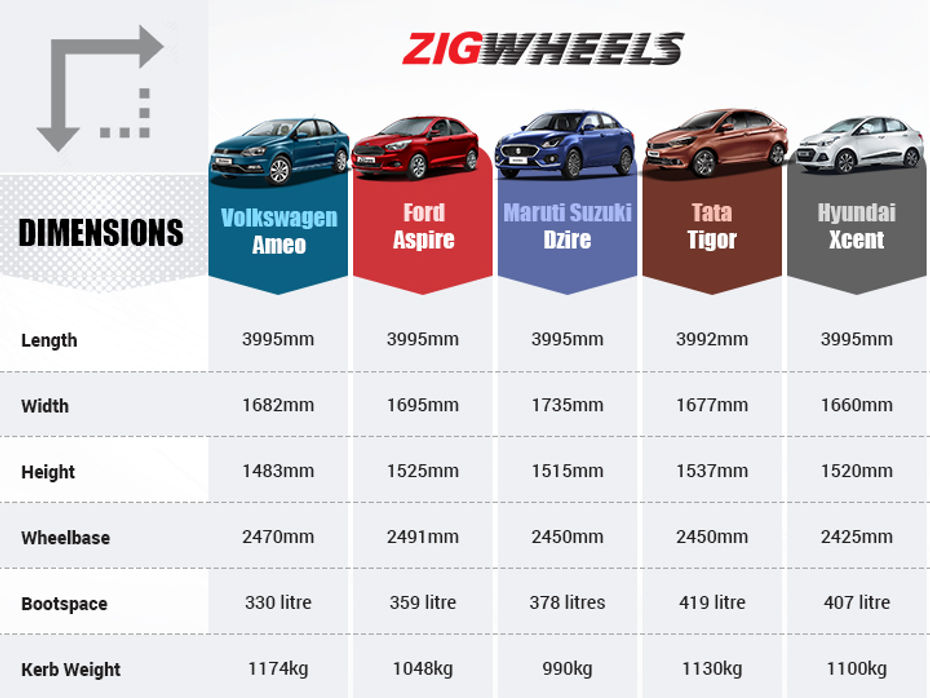
The Ameo, like the Polo has a really well designed beige-black cabin and there’s a delightful feeling of quality and durability to the switches and controls knobs. The seats are firm and supportive and there are places to store bottles on all four doors. It also features a rear AC vent for the back row. One complaint we had from a driver’s perspective was with the central armrest. Its position is such that it kept getting in the way while shifting gears and even when folded up, your elbow would bump into it while changing down. The Ameo is also a let down when it comes to stuffing three adults in the rear and when we say stuff, we mean it. Literally! Three abreast is a possibility but it’s all elbows and knees and not at all comfortable. Two adults is more the order of the day but there is not enough knee room to pass around for four full sized adults (front and rear) to be comfortable for long distances. It had the least knee room and headroom, of the five cars, for the rear seats.
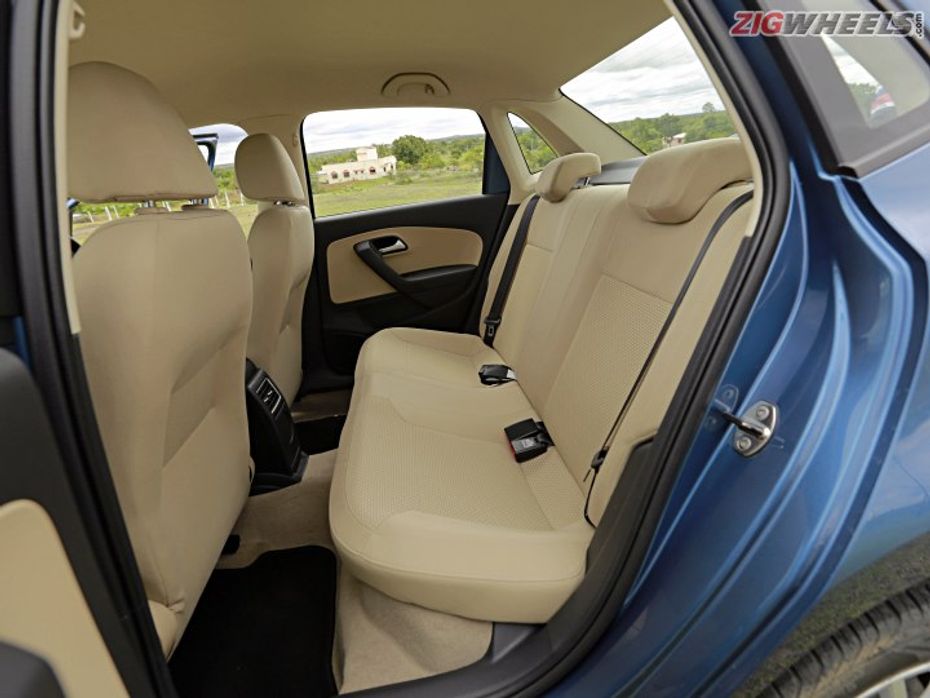
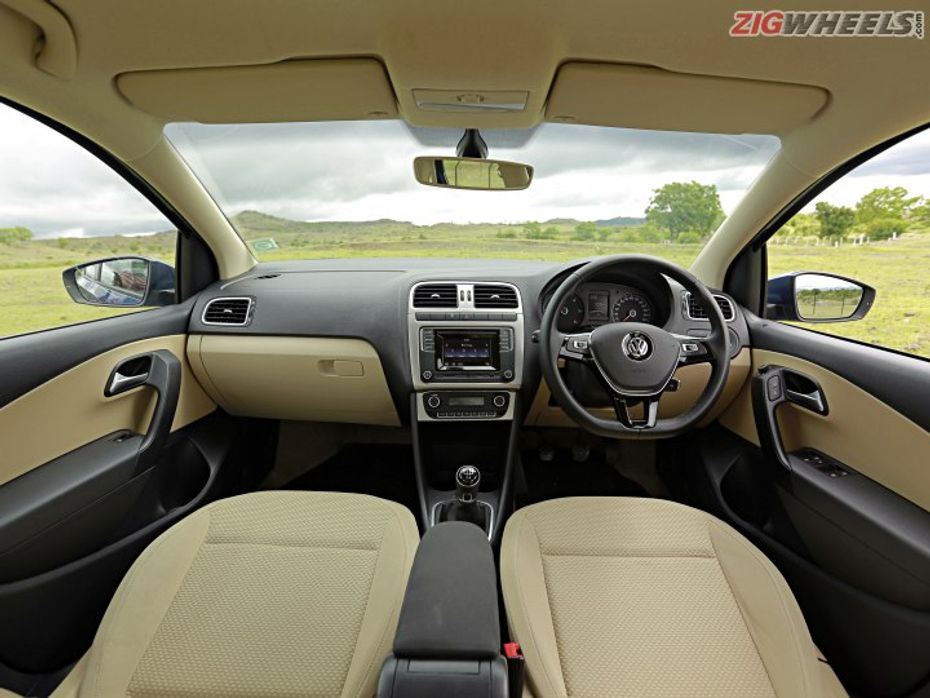
The Tigor can’t match the Ameo in the quality of its interiors, though the design and layout of the central console is quite attractive. The hexagonal entertainment unit is surrounded in a piano black plastic and has nice tactile control buttons, but features a rather small touchscreen in the centre. The plastics are hard but the nice cross-hatch design on the surface make them quite pleasant to touch. The are quite a number of cubby holes to store knick knacks and all four doors feature bottle holders. Seating three slim adults is a distinct possibility in the Tigor, though the shape of the rear bench means that the passenger in the centre will lack a little under thigh support. There is sufficient knee room for everyone to sit relaxed and it’s also quite airy. The Tigor cabin offers the maximum rear headroom, of the five on test, so six-footers better pay attention to this Tata.
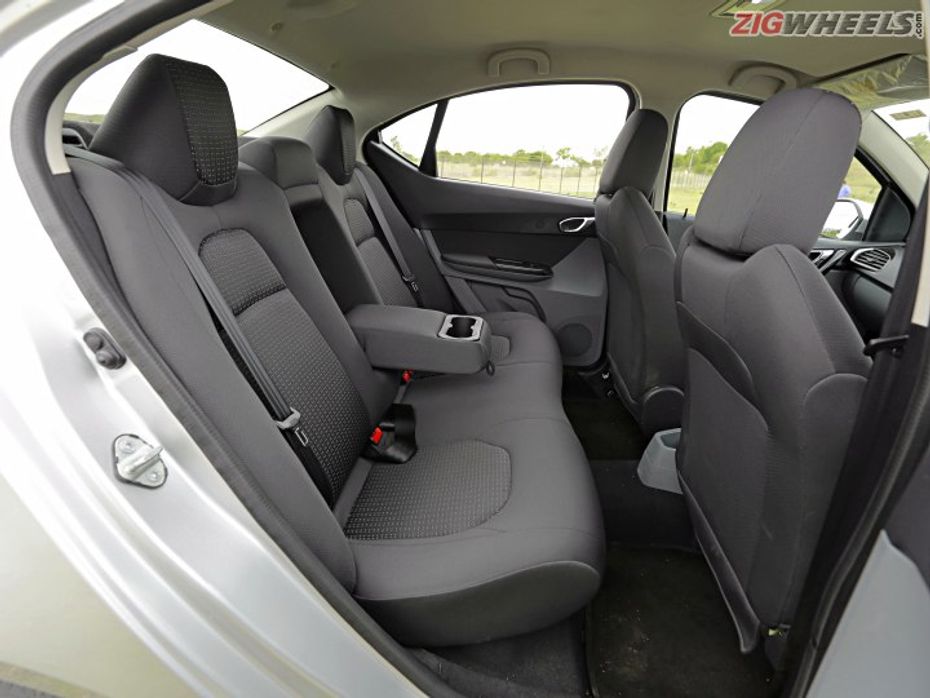
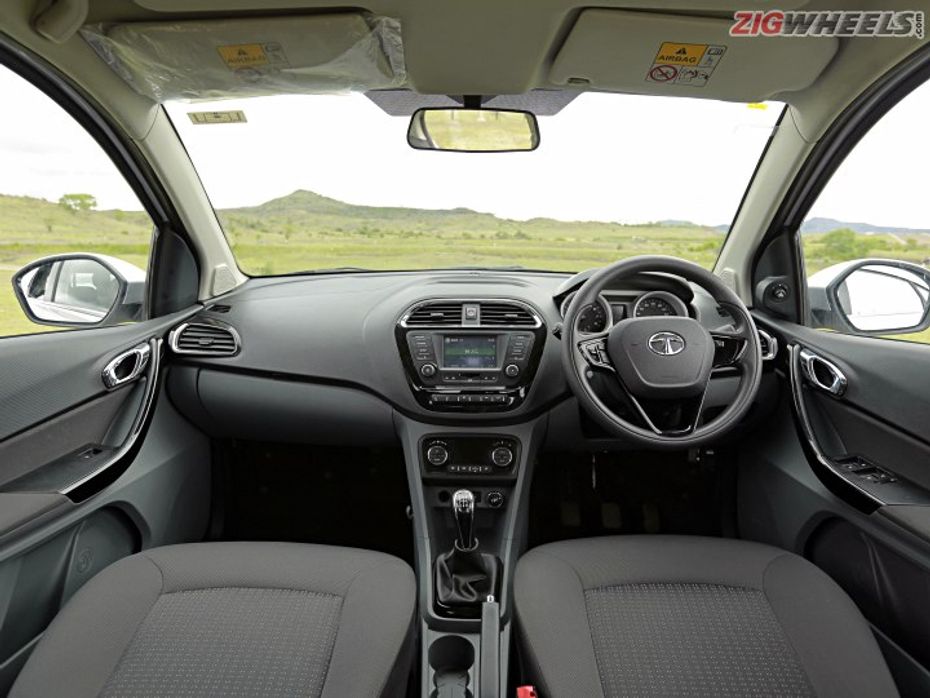
Next up is the Hyundai Xcent which is one of the nicest in terms of cabin design and layout. It’s also a beige-black color scheme and the plastics used are all soft wherever you’d care to touch them. It exudes that familiar feeling of premiumness that we have come to expect and appreciate from Hyundai cars. It’s also a very practical cabin with lots of cubby holes to store stuff and spaces for bottles on all four doors and has a set of dedicated AC vents for the rear seat passengers. It’s unfortunately let down by the space available in the passenger row. It’s the narrowest cabin of the five cars and this is quite evident when you try to seat three at the back. It’s not dissimilar to the experience in the Ameo, except that there is more knee room on offer in the Hyundai. For two passengers, it’s more comfortable though and there is just enough knee room for four adults to sit comfortably.
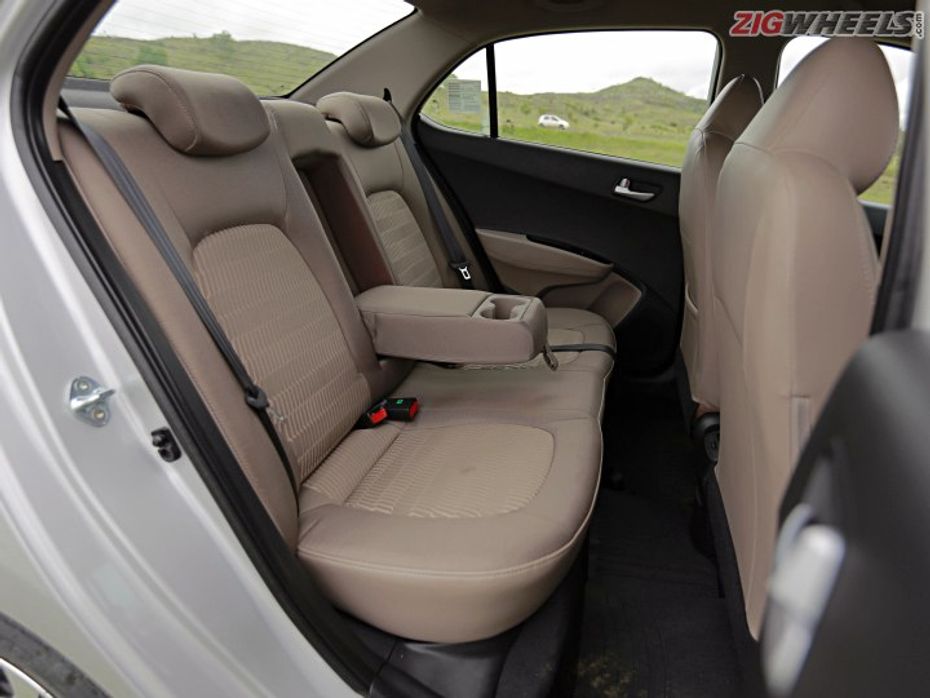
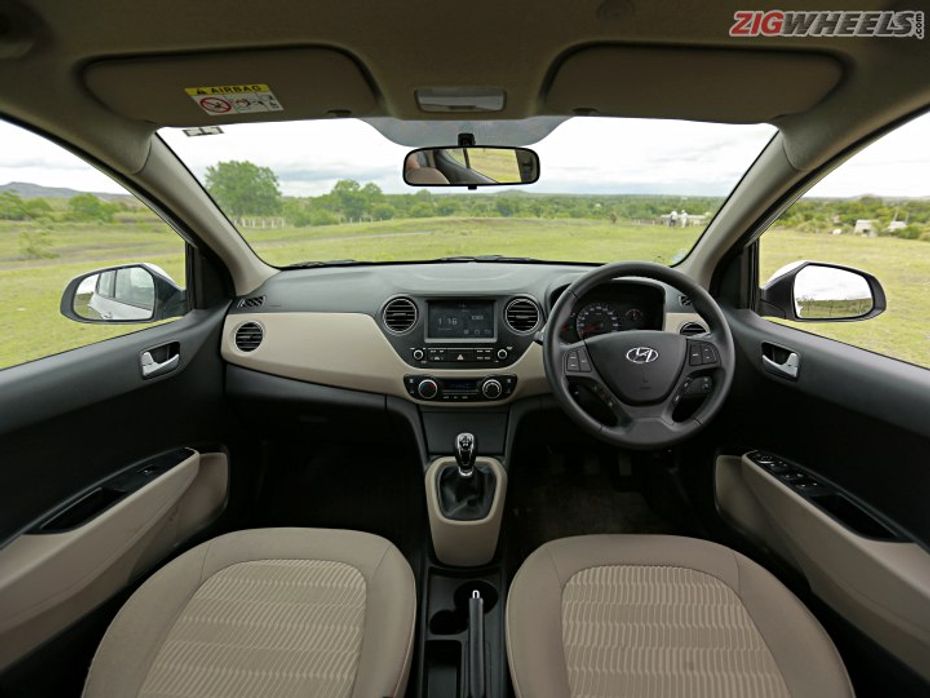
The Aspire’s interiors are a bit of a mixed bag with leather seats but quite a bit of hard touch plastics in easy to touch places. The central console unit was funky when it was launched but it’s starting to look a little dated now and the small four-inch monochrome screen doesn’t help its cause. There are ample storage spaces for bottles up front, but the rear doors don’t have any side pockets for bottles and there is only one central bottle holder and that takes up the space of a rear AC vent, that’s missing. Even the dropdown rear armrest doesn’t have cupholders that the other four do.
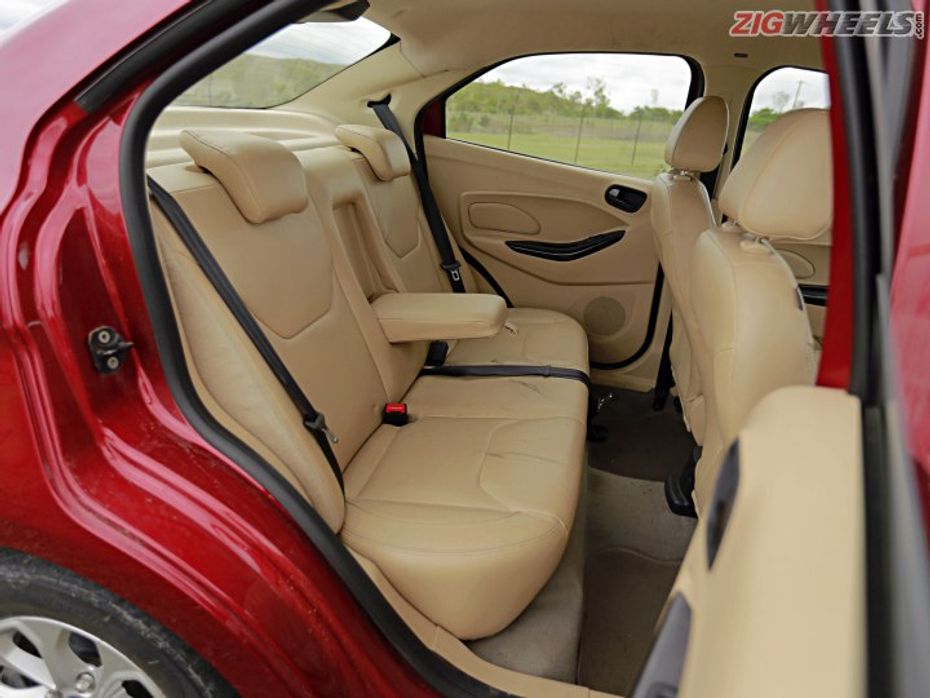
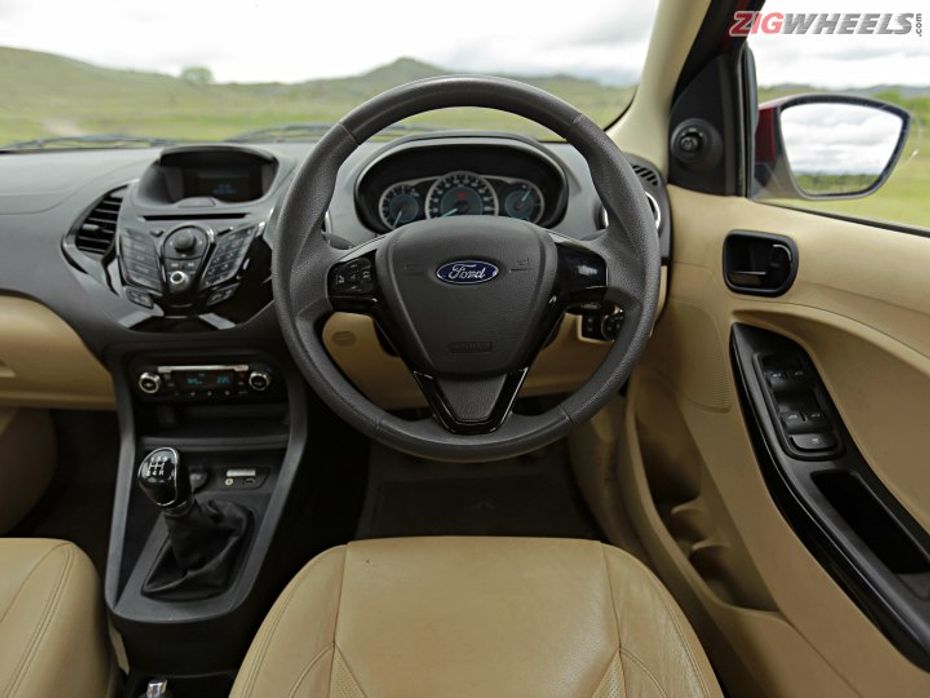
What the Aspire does well though, is offer space to its occupants. It’s the widest cabin up front with the most shoulder and legroom of the five. And though it may feature the least minimum. The rear bench will also fit three (slim) adults quite easily and they should be fairly comfortable for short distances too. Still it’s the second most spacious car on test here.
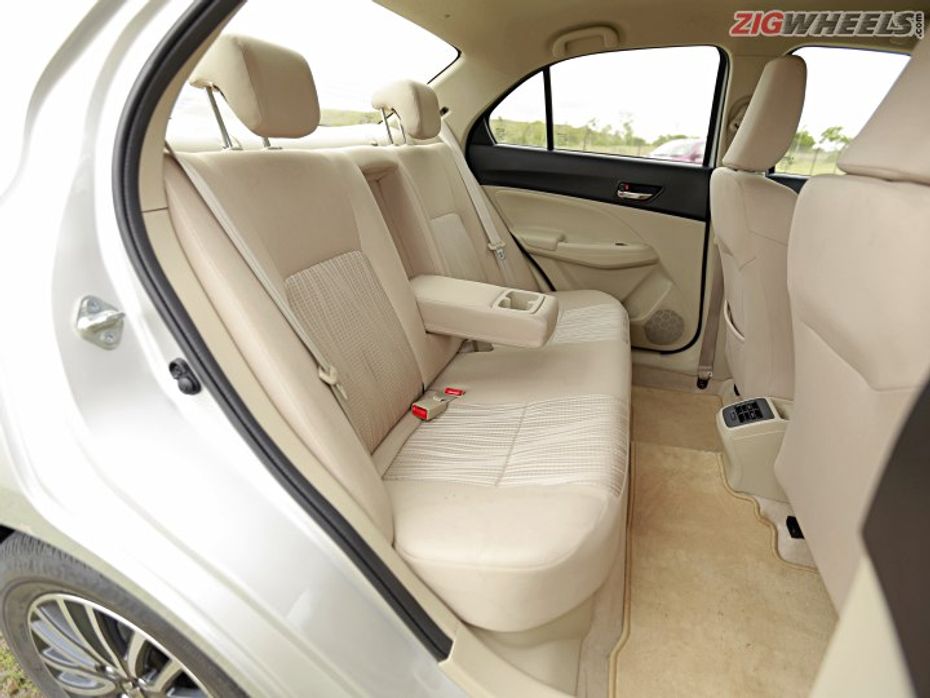
The engineers at Maruti must work some kind of magic because the Dzire has all the cars on test cleanly beat when it comes to interior space. Our three test dummies will be the most comfortable in the Dzire and the numbers back up their claims. It’s the widest passenger space both in terms of shoulder room and seat width and also features the most rear legroom. Adults definitely won’t be fighting over who rides shotgun, as we’re pretty sure they’d prefer stretching their legs at the back.
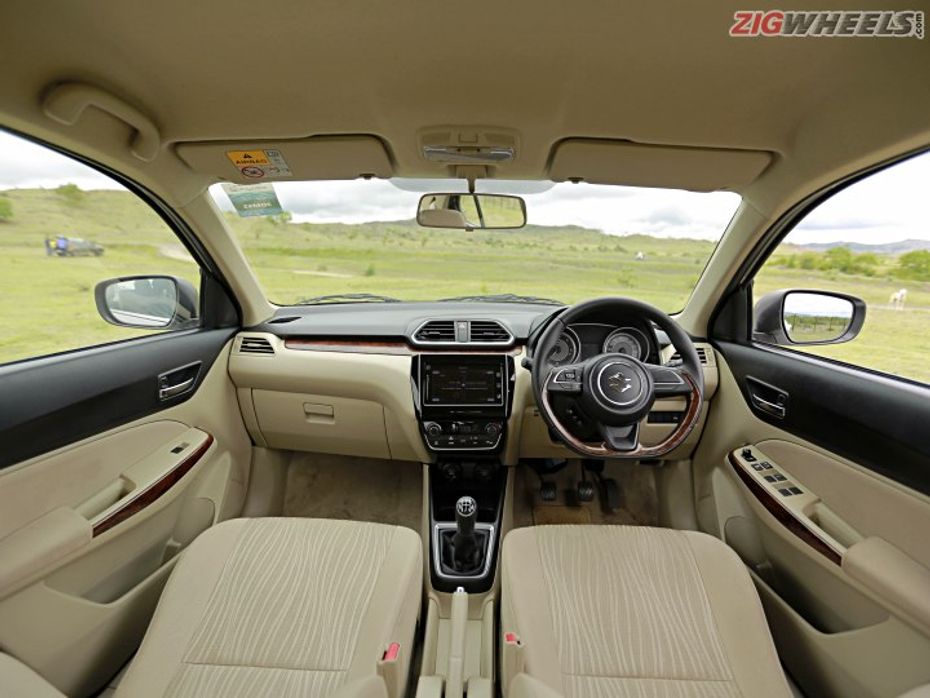
There is a lot more beige in the Maruti cabin than the rest, with just the top of the dashboard and the tops of the doors decked out in a black plastic with the rest of the cabin covered in a light beige fabric or plastic. The dash and steering wheel features faux wood inserts to give the interiors an upmarket feel. The light colour gives the Dzire’s cabin a distinct airy feel that further enhances that feeling of space, but the light colour will be a devil to keep clean in our climate. The interiors are also really practically sprinkled with storage spaces; bottle holders on all four doors and rear ac vents as well. It really hands down the most spacious and practical cabin of the lot and is at par with the Hyundai when it comes to premiumness and feel of the interiors, though it lacks the build quality of the Ameo.
Feature rich
With the duty benefits and close competition in a segment that averages approximately 35,000 units every month, it’s quite understandable that manufacturers will go to great lengths to make their products the most attractive. All the top-spec models on test are packed to the gills with features that at times shame some of their bigger C2 segment brethren. Most of the cars feature everything from touchscreens, reversing cameras/parking sensors, and power windows all around.
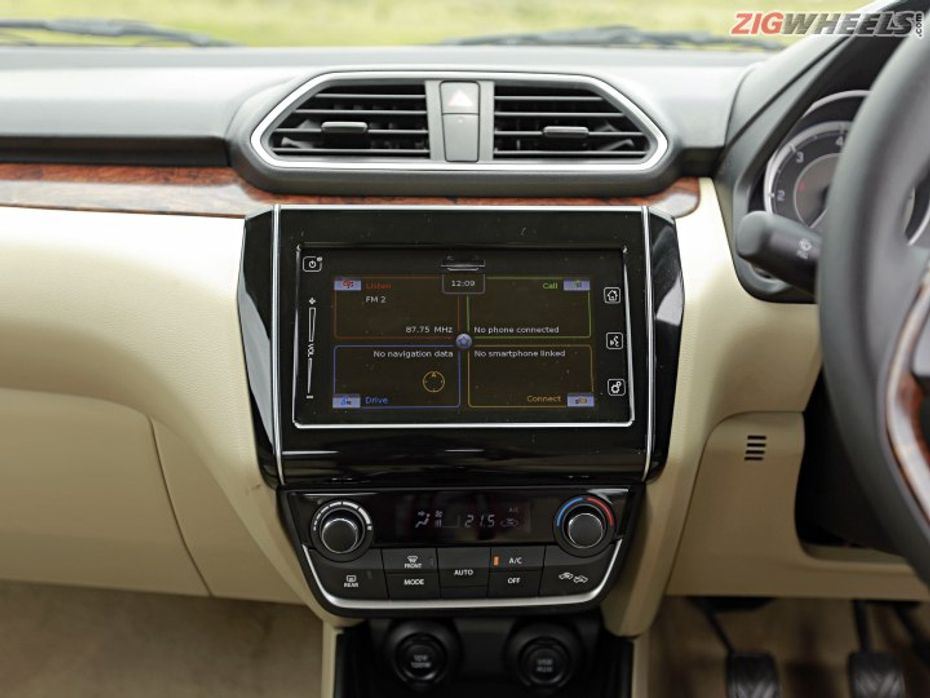
The Ameo has the longest feature list of the lot with some firsts for the segment too. It’s the only car to feature cruise control and rain sensing wipers. It also has one-touch up and down power windows all around, while the rest carry this feature on just the driver’s side windows. The Dzire is the newest kid on the block and has the most up-to-date feature list with LED headlamps, making it a first in the segment, and on the inside, it has a large touchscreen that supports Apple CarPlay, Android Auto. The Hyundai too offers this simple plug-and-play connectivity, while VW’s MirrorLink isn’t as friendly. The Hyundai’s feature list is equally long and in all three of these cars you will want for little when it comes to creature comforts and gizmos.
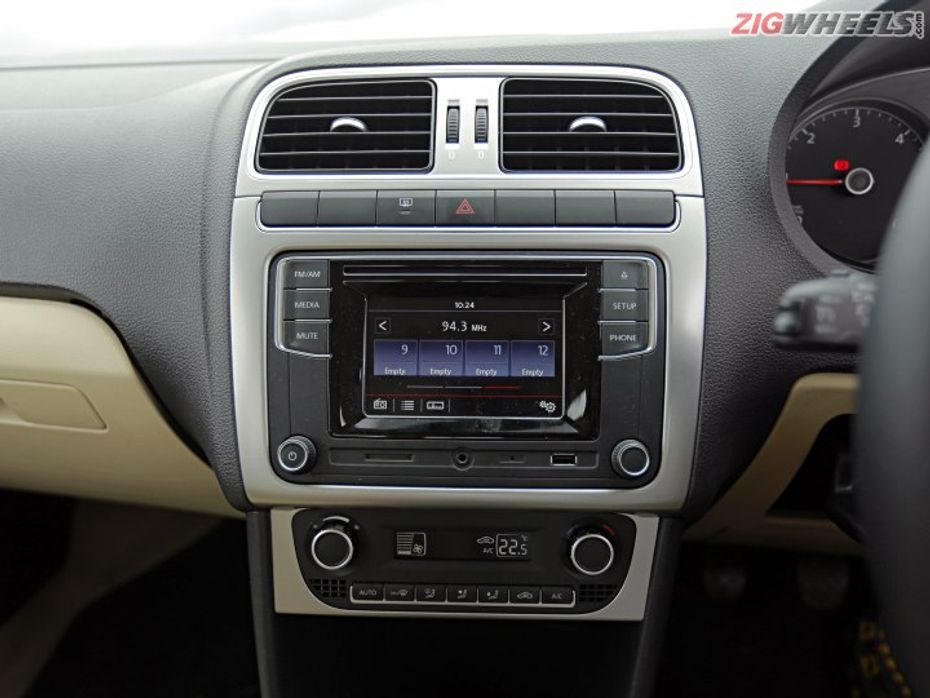
The Tata Tigor is next up with a similarly impressive features list, but it misses out on a few features like rear AC vents and the touchscreen is tiny and the least responsive of the lot. But it makes up ground with the great sounding eight-speaker Harman speaker setup. The Aspire really lags behind when it comes to features and in addition to missing out on AC vents for passengers at the back, its infotainment is the most dated. It does feature Bluetooth connectivity and voice commands to switch between functions and making calls but in this company, it is totally outclassed and in much need of an update.
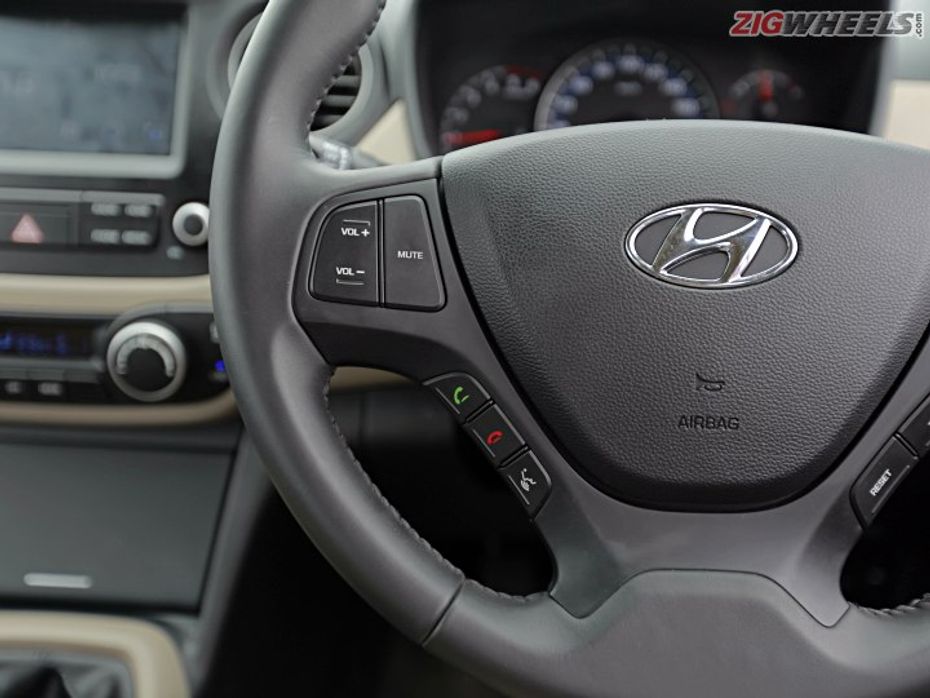
Pedal to the metal
When it was time to step behind the wheel and put some miles on the odometers, the Ameo and Aspire keys were the most sought after. Both cars make the most of the 1500cc displacement cap with 1.5-litre diesel powerplants. With over 110PS of power on tap behind each right pedal, they are the most rewarding to drive in a spirited manner. The Ameo makes the most torque on the test, pulling 250Nm to the Aspire’s 215Nm. But the Aspire is the more flexible engine with power flowing in a nice linear fashion, making it easier to drive at slower speeds as well. The more peaky power delivery of the Ameo makes it exciting to push on an open road, but a handful in town. Despite the slight deficit in torque, the Aspire is the faster accelerating, taking 10.75s to reach 100kmph and is nearly a second quicker than the Ameo when you’re pedal mashing.
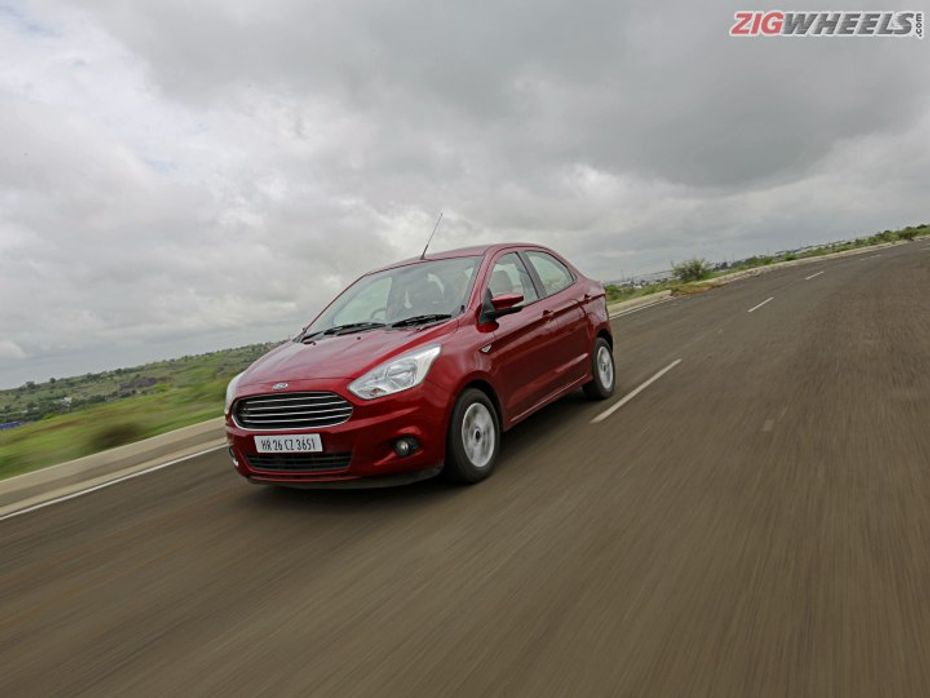
Out on the highway though, the Ameo is just a little more stable at higher speeds with the taut suspension keeping the car really flat. The Dzire and Xcent are a little slower in the sprint, but hold their own out on the highway. The Dzire’s chassis and suspension setup give it good body control and if you missed out in the rush for the Ameo or Aspire keys, then the Dzire’s were the next on your list. The Tigor was always the last to be picked and all down to the fact that its 1.1-liter engine is the least inspiring. Displacement equals torque and, that theory is borne out well here. The Tiago is also based on an older design platform and this means it weighs in a whole 140kg heavier than the featherweight Dzire. It tackles highways in a calm and unhurried fashion and no manner of prodding on the throttle or changing down of gear can change this attitude.
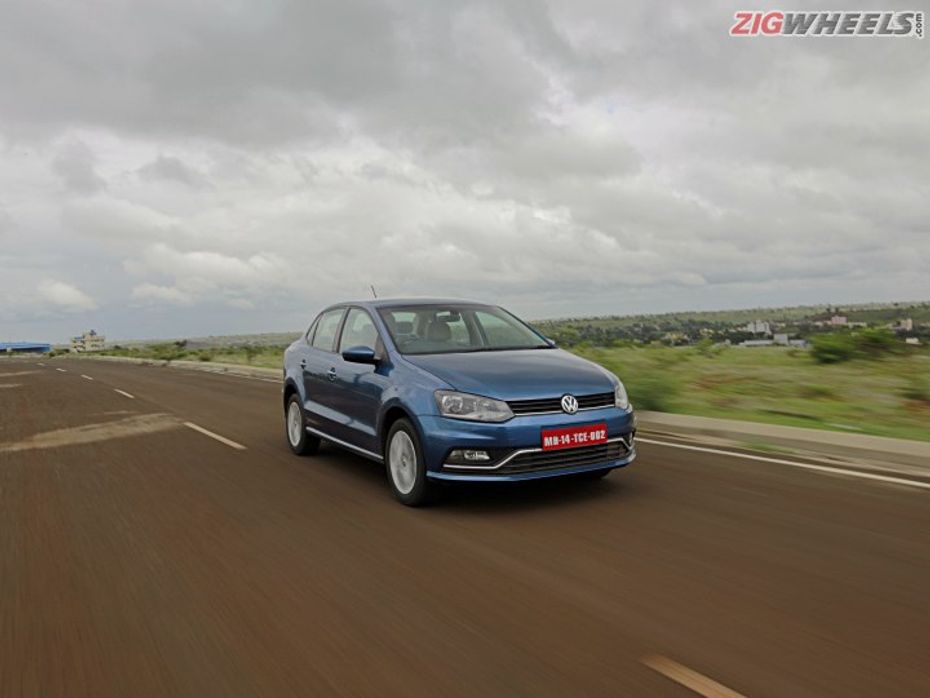

City slickers
What the Xcent and the Dzire lose out to the Aspire and Ameo on the highway, they gain back in spades around town. The Xcent is the easiest to drive around town with a nice light steering combined with a very tractable engine. The U2 CRDi powerplant is also the most refined in this test with very little noise or vibrations coming from the engine bay. Its suspension also absorbs bumps rather well and this all comes together to crown the Xcent urban king.
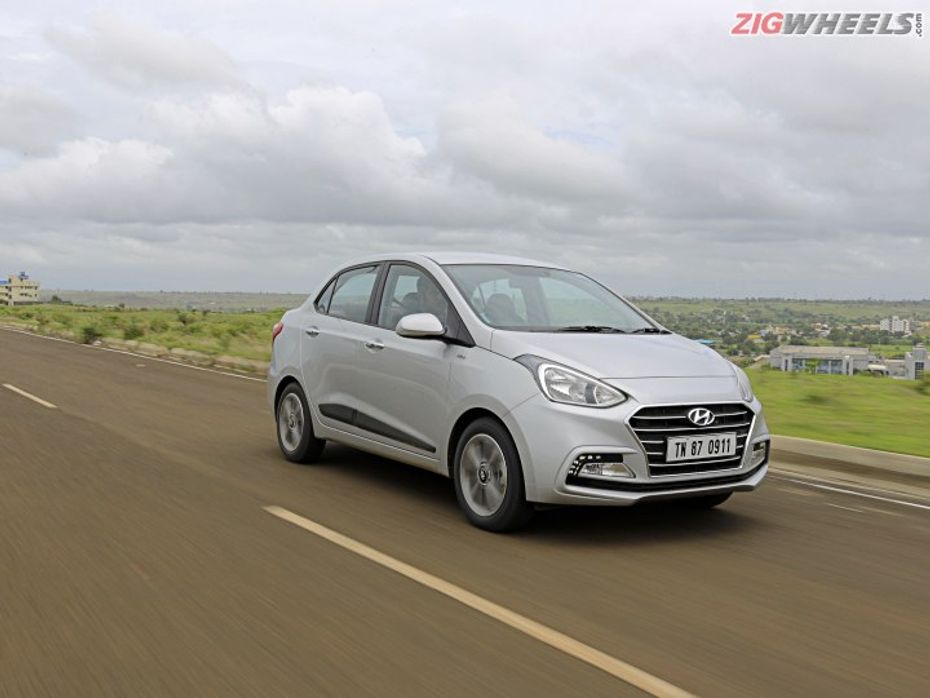
The Dzire’s up next with an equally refined powerplant and similar noise and vibration levels as the Xcent. It also pulls from fairly low in the rev range (1400rpm) but there is a slightly more pronounced kick at 2000rpm when the turbo really kicks in and only when compared to the Xcent does it seem a bit harder to drive in stop-go traffic. The light clutch though makes the shifts very easy. For the amount of composure it displays on the highway, it’s also very adept at absorbing undulations in the tarmac while still keeping side to side motion nicely controlled.

The Aspire and the Ameo are up next in terms of refinement with the Aspire just having the jump on the Ameo with a more linear engine and lighter steering. The Ameo’s steering is more of a handful and the peaky power delivery that comes in quite strongly at 1800rpm is also accompanied by a very clattery sound track from the engine bay. The Volkswagen does have the more controlled chassis but the stiff suspension setup means that it’s the least comfortable over bad roads. The Ford is better at absorbing imperfections but tends to bounce around as well and overall, it isn’t as capable as the Xcent or the Dzire around town.
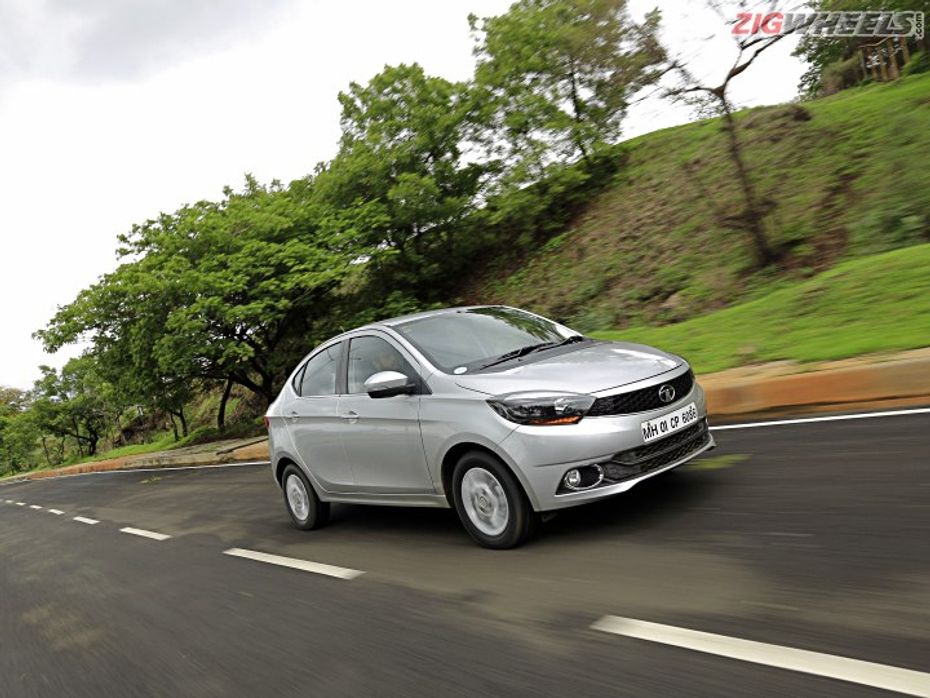
The Tigor is rather at home in the city with the steering weighted for comfort and the gentle nature of the Tata power plant is great for calm city driving. It’s the least refined of the lot though, with a lot of engine rumble and it competes with the Ameo for the din emanating from under the hood. The suspension is very capable at taking the edge off of bad sections of road and it’s only when compared, that the Tigor feels lacking. You do feel a bit more of the road as speeds increase and a bit more side to side movement also enters the equation.
Running on fumes
The Dzire and the Xcent also punch well below the 1500cc limit at 1.3-lires and 1.2-liters respectively, but the Hyundai makes do with one less cylinder as well. Their power outputs are near identical though, with both producing 75PS of power and 190Nm of torque. Understandably, they are not as quick as the Ameo or the Aspire but they don’t lag that far behind. With their smaller displacements, they have other bragging rights. The Dzire is the leader of the pack when it comes to sipping fuel, with a tested efficiency of 21.31kmpl on a combined cycle. The Hyundai is the next most efficient at 20.25kmpl. The Tata Tigor has the smallest engine but is only the third most efficient at 19.15kmpl and despite being more powerful, the Ameo and Aspire are not far off and at 17.93kmpl and 18.33kmpl respectively.
| EFFICIENCY | Dzire | Xcent | Tigor | Aspire | Ameo |
| City | 19.05 | 19.04 | 17.43 | 16.49 | 17.02 |
| Highway | 28.09 | 23.87 | 24.31 | 23.85 | 20.65 |
| ARAI | 28.4 | 25.4 | 24.7 | 25.83 | 21.73 |
| Zig Average | 21.31 | 20.25 | 19.15 | 18.33 | 17.93 |
(* - all figures in kmpl)
Who dares wins?
Tata are playing off the front foot with the diesel Tigor. It’s a refreshing design that is fairly practical and feature rich as well. It’s priced brilliantly and at Rs 6.87 lakh (all prices are ex-Delhi) it is a good two lakh rupees cheaper than the most expensive in this competition. It’s sadly let down by that lacklustre engine and as things stand, it’s bringing up the rear in this shootout.
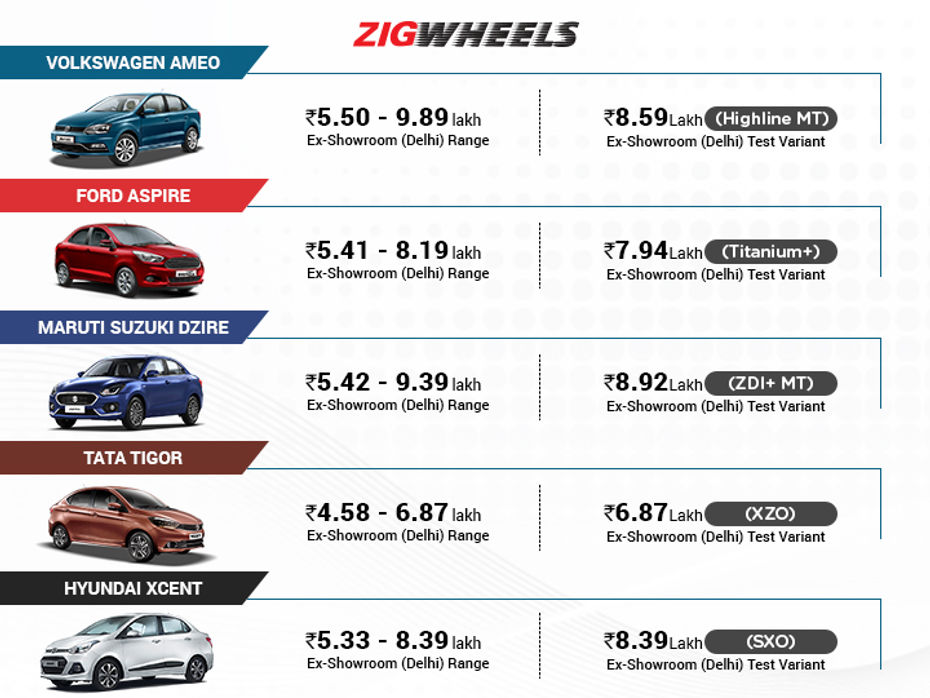
The Ameo boasts of the longest features list, is one of the most fun to drive and rules the roost out on the highway. But when it comes to space and comfort, it fails to offer a do-it-all solution that this market demands. At Rs 8.59 lakh it’s also the second most expensive on test.

Driving the Aspire is always fun. There is lots of space in the cabin and it’s the quickest when the red lights go out. But it’s not winning any medals in the race to offer a feature packed experience and is much in need of an update. Even the low asking price of Rs 7.94 lakh shouldn’t be enough incentive in this competition.
The Xcent cabin is premium and packed with features to keep everyone entertained and comfortable in any situation. Its refined and efficient engine is a delight to drive around town and doesn’t run out of steam on the highway either. It only falters when you try to fit three people in the rear bench. The asking price for the Xcent is Rs 8.39 lakh (ex-Delhi).
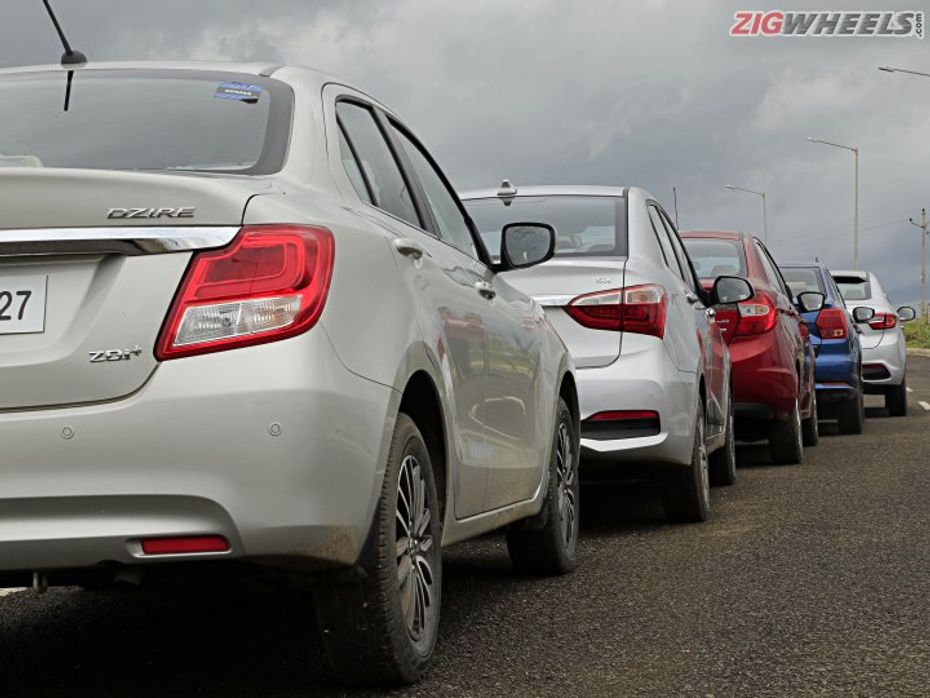
At Rs 8.92 lakh, the Dzire is the most expensive car on test but after laying everything down on the table, that doesn’t seem to matter. Maruti has taken the effort to tailor the Dzire to the segment and they appear to have succeeded in totality. It’s easily the most comfortable, packs all the features that you will ever need and is also the most efficient in the real world. While outright performance is lacking, everyday usability isn’t hampered as much. So, if the slight rattles from the plastics and those off-white interiors are the only chinks in its armour, then the new Dzire is the devil incarnate in the eyes of the competition.

Maruti Dzire vs Honda Amaze Diesel Manual: Road Test Review

Dzire vs Xcent vs Tigor vs Aspire vs Ameo: Comparison Review

Maruti Suzuki Dzire vs Baleno vs Brezza

Maruti Suzuki Dzire: Old vs New Variant Wise Comparison

Maruti Dzire Vs Sub-Four Metre Rivals - Spec Comparison

Honda Amaze vs Hyundai Xcent vs Maruti-Suzuki Swift Dzire Diesel...

Maruti Suzuki Baleno vs Hyundai Elite i20: Petrol Comparison Review

Maruti Suzuki Baleno DualJet Vs Rivals: Spec Comparo

Hyundai Grand i10 Nios vs Maruti Suzuki Swift & Petrol Comparison

Hyundai Grand i10 Nios Vs Maruti Suzuki Swift: Petrol Hatch Comparison
 Maruti Ciaz
Maruti Ciaz
 Tata Tigor
Tata Tigor
India's largest automotive community
 Maruti Suzuki Introduces This Safety Feature For The FIRST Time With The e Vitara, Along With 7 Other Comfort And Convenience Equipment
Maruti Suzuki Introduces This Safety Feature For The FIRST Time With The e Vitara, Along With 7 Other Comfort And Convenience Equipment
 Mahindra XEV 9e: Upsides And Downsides Of The Premium Electric SUV Coupe
Mahindra XEV 9e: Upsides And Downsides Of The Premium Electric SUV Coupe
 8 Features The Kia Syros Gets Over The Tata Nexon
8 Features The Kia Syros Gets Over The Tata Nexon
 Skoda Kylaq - Power-Packed Performance
Skoda Kylaq - Power-Packed Performance
 Maruti Dzire
Rs. 6.79 Lakh
Maruti Dzire
Rs. 6.79 Lakh
 Maruti Swift
Rs. 6.49 Lakh
Maruti Swift
Rs. 6.49 Lakh
 Maruti Ertiga
Rs. 8.69 Lakh
Maruti Ertiga
Rs. 8.69 Lakh
 Maruti FRONX
Rs. 7.51 Lakh
Maruti FRONX
Rs. 7.51 Lakh
 Maruti Brezza
Rs. 8.34 Lakh
Maruti Brezza
Rs. 8.34 Lakh
 Maruti Dzire
Rs. 6.79 Lakh
Maruti Dzire
Rs. 6.79 Lakh
 Hyundai Verna
Rs. 11.07 Lakh
Hyundai Verna
Rs. 11.07 Lakh
 Toyota Camry
Rs. 48.00 Lakh
Toyota Camry
Rs. 48.00 Lakh
 Hyundai Aura
Rs. 6.54 Lakh
Hyundai Aura
Rs. 6.54 Lakh
 Honda Amaze
Rs. 7.99 Lakh
Honda Amaze
Rs. 7.99 Lakh